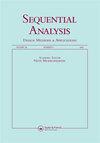Monitoring a Poisson process subject to gradual changes in the arrival rates
IF 0.6
4区 数学
Q4 STATISTICS & PROBABILITY
Sequential Analysis-Design Methods and Applications
Pub Date : 2019-07-03
DOI:10.1080/07474946.2019.1648923
引用次数: 2
Abstract
Abstract We look at a Poisson process where the arrival rates change from a known λ1 to a known λ2. Whereas in most of the literature the change-point is abrupt, we model the more realistic assumption that states that the change happens gradually over a period of time η where η is known. We calculate the probability that the change has started and completed. We also look at optimal stopping rules assuming that there is a cost for a false alarm and a cost per time unit to stop early. We conclude with some numerical results.监测到达率逐渐变化的泊松过程
摘要我们研究泊松过程,其中到达率从已知的λ1变为已知的λ2。尽管在大多数文献中,变化点是突然的,但我们对更现实的假设进行了建模,即变化在一段时间η内逐渐发生,其中η是已知的。我们计算变更已经开始和完成的概率。我们还研究了最优停止规则,假设有错误警报的成本和提前停止的每个时间单位的成本。最后给出了一些数值结果。
本文章由计算机程序翻译,如有差异,请以英文原文为准。
求助全文
约1分钟内获得全文
求助全文
来源期刊

Sequential Analysis-Design Methods and Applications
STATISTICS & PROBABILITY-
CiteScore
1.40
自引率
12.50%
发文量
20
期刊介绍:
The purpose of Sequential Analysis is to contribute to theoretical and applied aspects of sequential methodologies in all areas of statistical science. Published papers highlight the development of new and important sequential approaches.
Interdisciplinary articles that emphasize the methodology of practical value to applied researchers and statistical consultants are highly encouraged. Papers that cover contemporary areas of applications including animal abundance, bioequivalence, communication science, computer simulations, data mining, directional data, disease mapping, environmental sampling, genome, imaging, microarrays, networking, parallel processing, pest management, sonar detection, spatial statistics, tracking, and engineering are deemed especially important. Of particular value are expository review articles that critically synthesize broad-based statistical issues. Papers on case-studies are also considered. All papers are refereed.
 求助内容:
求助内容: 应助结果提醒方式:
应助结果提醒方式:


